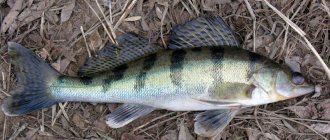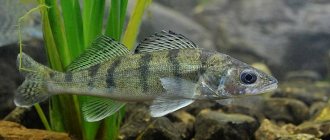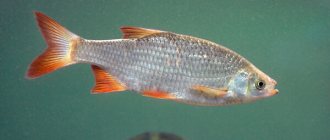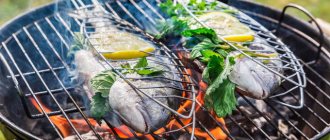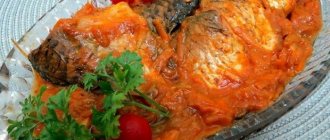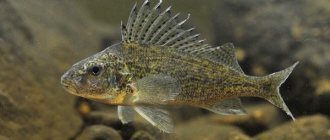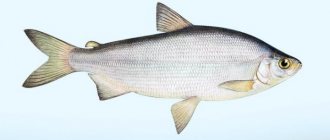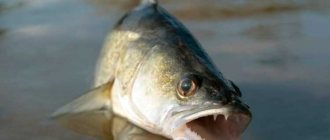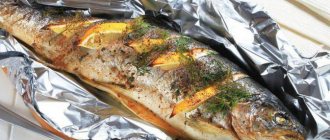Bersh fish: description
This fish belongs to the perch family. Bersh grows up to 0.5 meters in length and weighs up to 1.7 kg. Bersh, like perch, is considered a freshwater fish.
Description of appearance
Bersch has the same color as pike perch, only its stripes are more expressive and symmetrical. It is distinguished by a blunt muzzle and the absence of fangs on the lower jaw. The eyes are more convex than those of pike perch, and the fins, both dorsal and lateral, are large. The long body has an elongated shape. It is covered with large scales, and even at the mouth you can find smaller scales.
Where does bersh live?
Basically, bersh fish is found in rivers such as:
- The Volga River and the Volga River Basin.
- River Don.
- Donets River.
- Dnepr River.
In addition, this fish can actually be found in the Caspian Sea, as well as in its basin.
What does bersh eat?
Bersh feeds on small fish, not exceeding 7 cm in length, like pike perch. The most preferred fish is the gudgeon, although its diet includes fry of other fish species.
Prefers deep places where the bottom is hard and sandy. Not found in lakes, even flood lakes.
When does the bersh spawn?
Bersh is ready for breeding upon reaching 4 years of age. By this time, it grows up to 25 cm in length. The bersh spawns in shallow water areas. At the same time, he builds a special nest on the sandy bottom, within some snag. The male guards the nest where the eggs are laid until the fry emerge.
As a rule, it spawns in April or May, when the water warms up to +10 degrees. The caviar is quite small in size and yellow in color. Bersch is a fairly prolific fish, since the female can lay up to half a million eggs at a time, depending on the habitat.
The caviar ripens within one week. As a result, larvae appear, which remain in the cocoon for several days and feed on the remains of the shell. Their length (larvae) is several millimeters. After 5 days, the larvae turn into fish fry, which feed on zooplankton, and after growing up they switch to feeding on the fry of other fish.
Bersh behavior: features
Bersh, unlike the same pike perch, hunts for its prey throughout the day. Pike perch, by the way, go hunting at night. Bersch, like perch, hunts in schools, preferring to drive prey to a specific place.
Younger individuals stay close to large pike perch. Therefore, it is very difficult to distinguish bersh next to pike perch. Large specimens of bersha prefer to stay closer to the middle of the river, while smaller ones prefer to stay closer to the shore. At the same time, they are located at the very bottom.
Difference between bersh fish and pike perch
Despite the fact that some features of its behavior are almost similar to the behavior of pike perch, there are some differences. For example:
- Bersch does not grow to the same size as pike perch.
- You can see scales on the gills of the bersh, but the pike perch does not have them.
- Bersh is distinguished by large eyes, a shorter, but also wider muzzle.
- Bersh has larger scales.
- The stripes on the body of the bersh have a more regular geometry.
- Pike perch is found in lakes and reservoirs, while bersh prefers exclusively rivers, both large and small.
Fishing Features
Fishermen like to catch bersha because its fillet is unusually tasty and tender.
This type of predatory fish is hunted exclusively by non-professionals. This fish is not caught on an industrial scale. Fishing will be more successful in winter; in summer it is difficult to catch bersh. You should choose a fishing line of medium thickness, since individuals do not exceed 0.5 m in length. For winter fishing, you need to use large-sized jigs elongated along the contour. They put a gudgeon or other small fish on them.
As for gear, you can hunt for bersh using a spinning rod, donka or float rod. Some fishermen practice mug fishing. Spinning is suitable in this case because the predator lives on a sandy bottom. The bait should be light in color. No leash required. The bait should be played as smoothly and slowly as possible. This is done at the very bottom.
To locate a bersha site, it is necessary to study the bottom topography. Installation of the feeder is carried out in the evening . In the morning they go for a check. This method has many advantages. There is no need to cast the tackle regularly and check it. In addition, the use of artificial bait is allowed.
The bottom tackle has a sliding sinker. It is problematic to use a float rod in the current. This is why it is important to select areas where the water is relatively standing. This is also important because the bersh prefers a bottom-dwelling lifestyle. Float tackle is also difficult to throw over long distances.
What is circle fishing? This is a girder, but intended for fishing in the summer. Before using it, determine the location of the school of fish and then cast the tackle. In this case, it is better to use live bait. Large specimens are found in the river fairway. That's why you can't do without a boat here.
Fishing for bersha
Fishermen prefer to catch more bersha because it has more tender and juicy meat. But catching a bersh is not so easy. But if you try very hard and study his habits, then you can also cope with this task.
Catching bersh with a Somovka spinning rod
Fishing methods
There are more than enough ways to catch this fish, especially in our time. At the same time, there are those that are extremely popular among fishermen, and there are those that are not very popular. In any case, they can bring positive results.
The process of catching bersh is accompanied by a lot of positive emotions. At the same time, it is enough to arm yourself with the simplest and most affordable gear. Despite this, you need to know some information about him. For example:
- This fish is caught exclusively by amateur fishermen. Bersha is not caught on an industrial scale.
- Catching bersh in the summer is not at all realistic, but with the arrival of winter you can count on success.
- For fishing, choose a fishing line of medium thickness, since the bersh does not grow more than 0.5 meters in length.
- Basically, large, elongated jigs are used to catch it in winter.
- Some kind of fish, such as redfish, gudgeon or sprat, is attached to the jig.
Catching pike perch and bersh on the Sura.
Fishing gear
Bersh can be caught using any gear, such as:
- Spinning . Since this fish prefers a sandy bottom, a spinning rod is excellent for catching this predator. A light-colored spoon is used as bait. A leash, in this case, is not needed. The bait should be placed at the very bottom, and quite slowly. It is better if fishing is done from a boat. It is equally important to determine the bottom topography in order to find a fish site.
- Bottom fishing rod (feeder). As a rule, gear is installed in the evening and checked in the morning. This method of fishing has a number of advantages. Firstly, you don’t need to constantly cast and pull out the tackle, and secondly, you can use artificial bait. Bottom tackle is used with a sliding sinker.
- Float rod . It is quite difficult to fish with this fishing rod, especially in the current, especially since bersh leads a bottom-dwelling lifestyle. Therefore, you need to choose areas with moderate currents. In addition, float tackle is difficult to cast far.
- Fishing with mugs . The circle is the same girder, only for fishing in the summer. First, you should determine the concentration of fish and only then cast the tackle. When fishing with mugs, live bait is usually used. Large specimens are located somewhere on the river fairway, where you need to throw gear and here you can’t do without a boat.
Catching bersh Spinning Boat jig
Fishing Features
Fishermen like to catch bersha because its fillet is unusually tasty and tender.
This type of predatory fish is hunted exclusively by non-professionals. This fish is not caught on an industrial scale. Fishing will be more successful in winter; in summer it is difficult to catch bersh. You should choose a fishing line of medium thickness, since individuals do not exceed 0.5 m in length. For winter fishing, you need to use large-sized jigs elongated along the contour. They put a gudgeon or other small fish on them.
As for gear, you can hunt for bersh using a spinning rod, donka or float rod. Some fishermen practice mug fishing. Spinning is suitable in this case because the predator lives on a sandy bottom. The bait should be light in color. No leash required. The bait should be played as smoothly and slowly as possible. This is done at the very bottom.
To locate a bersha site, it is necessary to study the bottom topography. Installation of the feeder is carried out in the evening . In the morning they go for a check. This method has many advantages. There is no need to cast the tackle regularly and check it. In addition, the use of artificial bait is allowed.
The bottom tackle has a sliding sinker. It is problematic to use a float rod in the current. This is why it is important to select areas where the water is relatively standing. This is also important because the bersh prefers a bottom-dwelling lifestyle. Float tackle is also difficult to throw over long distances.
What is circle fishing? This is a girder, but intended for fishing in the summer. Before using it, determine the location of the school of fish and then cast the tackle. In this case, it is better to use live bait. Large specimens are found in the river fairway. That's why you can't do without a boat here.
Useful properties of bersh
Fish, unlike animal meat, contains much more useful components. In addition to being nutritious, fish meat is also low in calories. In this regard, we can safely classify bersh meat as a dietary product. At the same time, its meat is quickly absorbed by the body.
The presence of vitamins and microelements in the meat of a predator, along with other useful substances, allows the human body to be replenished with almost all components that have a beneficial effect on the functions of the human body. Moreover, all components act comprehensively, improving the functioning of the kidneys and liver, refreshing the condition of the skin, strengthening bones and stimulating tissue regeneration.
Regular consumption of fish allows you to cleanse the body of toxins and waste, while increasing the overall tone of the body, while improving metabolism. In addition, some components have a positive effect on the functions of the central nervous system.
Delicious recipes from bersh
From such a predator as bersh, it is possible to prepare various delicious dishes. At the same time, the dishes are not only tasty, but also healthy.
QUICK COOKING BERSHA “LAZY STYLE”
Stewed berche with onions covered with cheese crust
To prepare this very tasty dish you need to prepare:
- Half a kilo of fish.
- Three onions.
- 150 grams of hard cheese.
- 70 grams of mayonnaise.
- Greenery.
- Salt.
- Spices.
Cooking technique:
- First of all, the fish is cleaned, gutted and washed thoroughly. If you remove all the bones, you will get a more desirable dish. After this, the fish is cut into portions, salted and peppered.
- The onion is cut into half rings and mixed with mayonnaise.
- The oven turns on and heats up to the desired temperature. The fish is coated with mayonnaise and onions and placed in a baking dish. In this state, the fish should cook for about 35 minutes.
- After this time, the fish is removed from the oven and the dish is sprinkled with grated hard cheese on top. After this, the fish goes into the oven for another 5 minutes. Before serving, the dish is decorated with chopped herbs.
Bersh with greens
The following components will be required:
- 4 medium sized fish carcasses.
- Dill.
- 6 cloves of garlic.
- Parsley.
- Basil.
- Green onions.
- 3 tablespoons of mayonnaise.
- Vegetable oil.
- Salt.
- Pepper.
How to cook:
- The fish is cleaned, gutted and washed thoroughly. At the same time, you must remember to cut off the heads, fins and tail.
- All greens are chopped, placed in a separate container, with the addition of garlic juice and vegetable oil. After this, all this is salted to taste.
- Fish carcasses are stuffed with prepared herbs. At the same time, this mixture should be thoroughly coated with the inside of the belly of the fish. The top of the fish is coated with mayonnaise.
- The fish is placed on a baking dish and sent to the oven for about 40 minutes until the fish is covered with a golden crust.
Fish dishes. Bersh baked with bacon.
Despite the fact that in this recipe I combined seemingly incompatible ingredients, the result was a very tasty, juicy and unusual dish for the holiday table. The idea to put everything together in exactly this sequence arose spontaneously when I found out that my long-time friend Oscar was coming to visit us.
It’s difficult to surprise a fisherman with fish dishes, so I had to improvise.
Products:
- Bursh fish - 5 pcs.;
- Potatoes - 5-6 medium tubers;
- Bacon - 250 grams or 10 strips;
- Tomato - 2 pcs.;
- Onion - 1 large head;
- Soy sauce - 70 gr.;
- Vegetable oil - 30 gr.;
- A bunch of green onions and dill;
- Bay leaf, suneli hops, pepper, salt.
If the sequence of actions is correctly distributed, then the process of preparing a dish by one person takes no more than an hour and a half.
We clean the bersha, carefully open it so as not to damage the integrity of the caviar too much, remove the entrails and gills, collect the caviar separately, and fillet the fish.
The next step is to marinate the fillet in soy sauce with seasonings. Lay out a layer of fish, sprinkle with seasonings, pour over a little soy sauce
then lay out the second layer of fish, repeat all the same steps... etc.
All! For 30 minutes, forget about the fillet; it should be well soaked in sauce and spices at room temperature.
We need to prepare fish shurpa from the heads and ridges and then serve them correctly. Pour 2 liters of water into the pan, put the bersha frames there and put the pan on the fire.
Peel the potatoes, cut them into large pieces, and put them to cook in another pan.
We constantly monitor the pots, but continue to mind our own business. Thinly slice the bacon, peel the onion, prepare a baking sheet and wire rack (grease them with vegetable oil). As soon as the fish extract starts to boil, remove the foam and turn the gas to minimum (so that it barely gurgles). Next, we wait for the potatoes to boil, throw one Magi cube into it, reduce the gas and cut off for 5-7 minutes, after which we remove the pan from the stove and drain the water.
By this time 10 strips of bacon have already been cut
(you need to cut them as thin as possible). We cut everything that is left into small cubes, throw it into the hot potatoes, mix well, cover the pan with a lid and let it sit for about five minutes.
So far this and that, about 30 minutes of time have just passed, the bersha fillet has absorbed the sauce and spices, and the rest of the ingredients are ready to be added.
Place potatoes with pieces of bacon on a baking sheet greased with sunflower oil, place a wire rack on the baking sheet (it is also greased with oil),
on the grill - fillet,
on the fillet - strips of bacon.
It's okay if the bacon is torn or does not cover all the fillets. Its task is not to bring beauty, but to soak the fish, making it juicy, and drip onto the potatoes, helping them absorb the aroma of fish and spices.
Once all the products have been collected for baking, place the baking sheet together with the wire rack in the middle groove of an oven preheated to 200 degrees. *Not separately to different levels, but together to one level. The groove is wide, so everything works out without difficulty . —
We slammed the oven door, and immediately we remembered the skeletons with their heads languishing in the second pan.
Using a colander, strain the broth into a clean saucepan, put it on high heat, add finely chopped onions, tomatoes, bay leaves, and bersha caviar. Add a little salt and pepper to taste. As soon as it boils, reduce the gas to minimum, cook the fish shurpa for about 5 minutes, turn off the gas and let the shurpa rest.
There are about 10 minutes left until the main dish is ready. During this time, finely chop the greens into separate bowls: dill and onion; We prepare the dishes: for the main course, for shurpa. In general, we begin to deal with the last stage, namely the submission.
After about 30 minutes, the potatoes with buffalo should be completely baked (look at the readiness of the potatoes). Remove the baking sheet with the wire rack from the oven and immediately, while hot, pour the fillet with bacon and green dill.
Sprinkle the potatoes themselves with dill and green onions, mix everything right on the baking sheet, and then put it on a large flat plate.
Attention! The fish must be allowed to stand for about five minutes, otherwise it will not separate well from the grill. Then, carefully use a spatula to lift the fillet and place it on top of the baked potato.
The final touch is shurpa. Pour fish broth into a deep bowl, sprinkle it with herbs, put in it (if available) a boiled game of bersha and... well, off we go-))) ... “okay, everything will be fine, everything will be fine, I know it!” (film “Gorko”) -
But seriously, this is a really unusual and very interesting dish, both in terms of taste and presentation. We got both the first and the second, and the “compote” is optional. By the way, the beauty of bacon is that it does not “overwhelm” the taste of fish, since lard and meat do not have a distinct odor.
Bon appetit.
